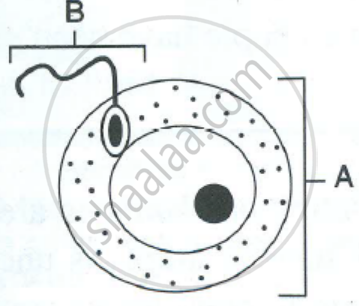Advertisements
Advertisements
प्रश्न
Write the functions of the following organs of reproduction:
a. Ovaries
b. Seminal vesicle and prostate glands
उत्तर
(a) Functions of ovaries:
a. They produce eggs.
b. The eggs are released from the ovaries by the process of ovulation.
c. The ovaries also secrete the female sex hormone oestrogen, which brings about changes in girls at the time of puberty.
(b) Functions of seminal vesicle and prostate glands:
a. They produce the ejaculatory fluid.
b. This fluid helps in the transport of sperms and provides nutrition to the sperms.
APPEARS IN
संबंधित प्रश्न
Describe, in brief, the changes the uterus undergoes
(i) to receive the zygote.
(ii) if zygote is not formed
Suggest three contraceptive methods to control the size of human population, which is essential for the health and prosperity of a country. State the basic principle involved in each.
Write the function of the following part in a human female reproductive system:
Fallopian tube
Give scientific reasons: Mature erythrocytes in humans lack nucleus and mitochondria
fill in the blanks with suitable functions: Seminiferous Tubule and _____
Choose the ODD one out from the following terms given and name the CATEGORY to which the others belong :
Prostate gland, Cowper’s gland, seminal vesicle, seminiferous tubules
Given below are diagrams showing the different stages in the process of fertilisation of an egg. in the human female reproductive tract.
Study the diagrams and answer the questions:
1) Arrange the letters given below each diagram in a logical sequence to show the correct order in the process of fertilisation.
2) Where does fertilisation normally take place? and What is ‘Implantation’ that follows fertilisation?
3) Mention the chromosome number of the egg and zygote in humans.
4) Explain the term ‘Gestation’. How long does Gestation last in humans?
5) Draw a neat, labelled diagram of a mature human sperm.
Name the liquid that contains sperms.
For how much time does menstruation last in human females (or women)?
Write the names of male sex hormone?
What is gestation period? How much is the gestation period in humans?
fertilisation in humans can occur only once in a month. Why?
What is the scientific name of womb?
What is the life support system of a fetus?
Name the organs which produce ova (or egg cells) in human females.
Describe the process of fertilisation in humans and development of embryo briefly.
One of the following is not a part of the human male reproductive system. This is
(a) testis
(b) oviduct
(c) seminal vesicle
(d) prostrate gland
Which of the following is not a sexually transmitted disease?
(a) gonorrhoea
(b) hepatitis
(c) syphilis
(d) AIDS
Fertilisation results immediately in the formation of :
(a) a zygote
(b) an embryo
(c) a placenta
(d) a foetus
In human males, the testes lie in the scrotum outside the body because it helps in the
(a) process of mating
(b) formation of sperms
(c) easy transfer of sperms
(d) all the above
Which among the following are not the functions of testes at puberty?
(i) formation of germ cells
(ii) secretion of testosterone
(iii) development of the placenta
(iv) secretion of estrogen
The diagram below represents two reproductive cells A and B. Study the same and then answer the questions that follow:
 |
- Identify the reproductive cells A and B.
- Name the specific part of the reproductive system where the above cells are produced.
- Where in the female reproductive system do these cells unite?
- Name the main hormones secreted by the (1) ovary (2) testes.
- Name an accessory gland found in the male reproductive system and state the function of its secretion.
Trace the path of sperms from where they are produced in human body to the exterior.
Define the term puberty.
List and explain in brief three methods of contraception.
Choose the correct answer:
Binary fission is a method of __________
Choose the correct answer:
When pregnancy does not occur, the life of corpus luteum is about _____________
Name the following:
Organ where implantation takes place.
Give the functions of the following:
Vagina
Define the following:
Gestation
Name the Following
What does this abbreviation stand for LH?
Give Technical Term:
What are the age restrictions for marriages by law for boys and girls in India?
State the Location:
Uterus
Multiple Choice Question:
What will happen if the temperature of the scrotal sacs temporarily goes to about 2°C lower than body temperature?
The following is the illustration of the sequence of ovarian events (a-i) in a human female.

Write the difference between C and H.
The membranous cover of the ovum at ovulation is ______.
Reproductive organs are also considered endocrine glands.
Arrange and rewrite the terms in the group in the correct order to be in a logical sequence beginning with the term that is underlined:
Testis, Urethra, Sperm duct, epididymis.
